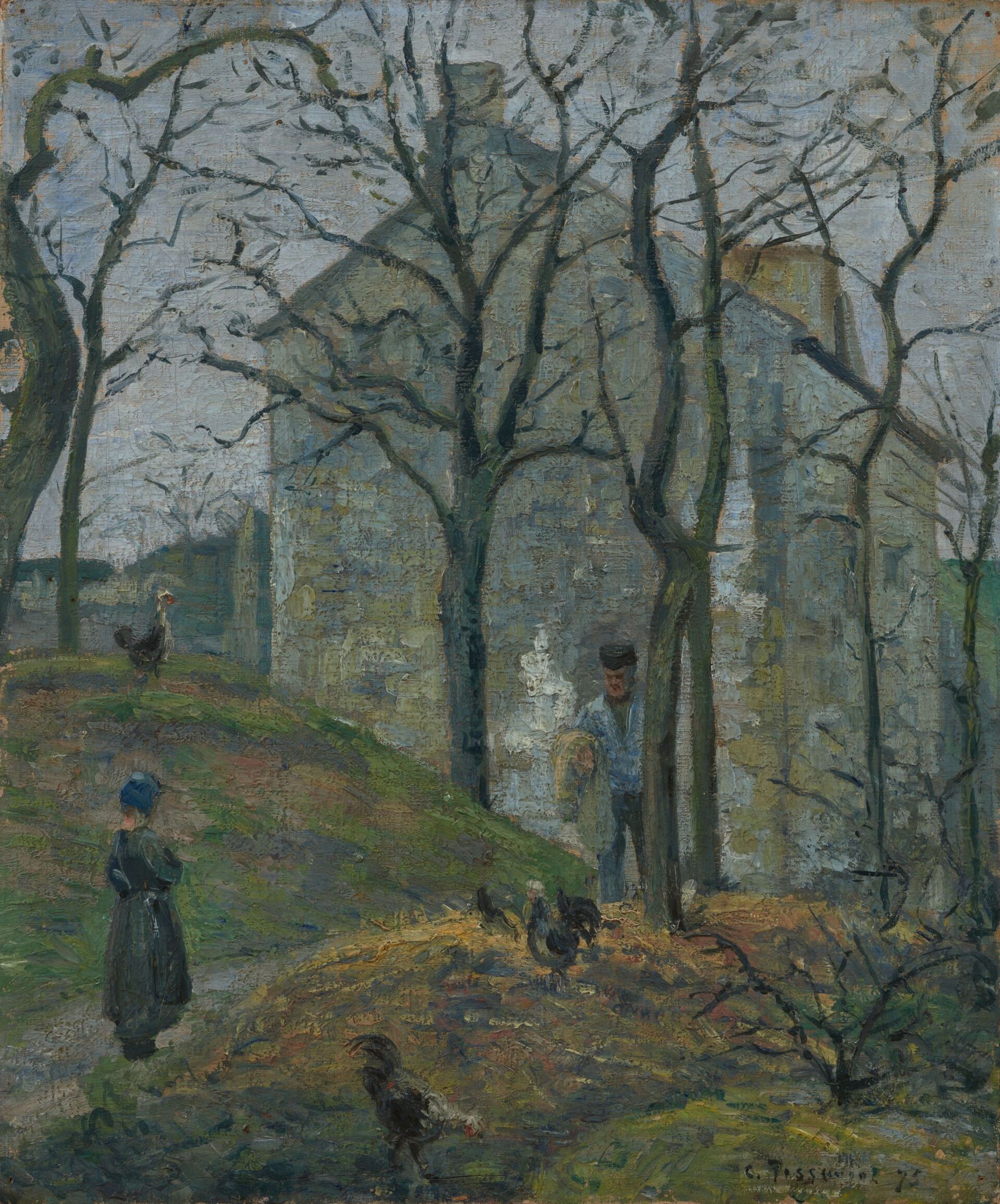Camille Pissarro, La Maison Rondest, l'Hermitage, Pontoise, 1875
Processing and agreement
Kunstmuseum Basel will compensate the heirs of the Jewish entrepreneur Richard Semmel (1875-1950) for a painting he sold in 1933 while in the process of emigrating. The decision to ensure a “just and fair solution” represents a commitment to the Washington Principles and to the museum's own provenance research strategy. The Kunstmuseum is delighted to be able to retain the work in its collection and the heirs are satisfied with the solution.
The Kunstmusem Basel received La Maison Rondest, l'Hermitage, Pontoise as a gift on the occasion of the exhibition Camille Pissarro. The Studio of Modernism (September 4, 2021–January 23, 2022). Originally part of the Riehen collection of Dr. Klaus von Berlepsch, the work was to appear in the exhibition as a loan, but even before the exhibition opened Von Berlepsch had decided to donate the work to the Kunstmuseum. The painting was listed as wanted on the website www.lostart.de. However, because this listing was under a different title and was not accompanied by an image, the work’s history did not attract immediate attention when the donation was accepted. The painting’s donor, Von Berlepsch – now deceased – was also unaware of its origins. When the provenance was checked after the painting entered the collection, prior ownership by the Jewish entrepreneur Richard Semmel was quickly revealed. Since the adoption of the Kunstmuseum’s Provenance Research Strategy in 2022, it is standard practice for this kind of research to take place before donations are accepted.
Richard Semmel began putting his art collection up for auction in 1933 after fleeing from Germany, which raised the suspicion that there may be a connection between the sale and his persecution by the Nazis.
Who was Richard Semmel?
The German-Jewish textile entrepreneur Richard Semmel came from Sobotka in Lower Silesia, in what is now Poland. He was married to Claire (Cäcilie), née Bruck. The couple had no children. Semmel owned the Berlin linens manufacturing company Arthur Samulon, which he headed as sole shareholder starting in 1919. Under his leadership, the company experienced considerable growth in size and sales revenue. In addition, he owned the realty holding company Arthur Samulon Grundstücks G.m.b.H. In the spring of 1933, Semmel was already beginning to face the threat of reprisals from the Nazi regime. In June of that year, he and his wife emigrated to the Netherlands, which was still unoccupied at the time. According to his own statement, Semmel left Germany not only due to “racial” persecution by the Nazis, but also because he was accused of having ties to the Social Democratic party. In June 1939, the couple fled again – to New York, via Santiago de Chile. The Semmels' living conditions in the USA were marked by poverty and poor health. After Claire Semmel’s death in 1945, the ailing Richard Semmel was taken care of by an acquaintance from their Berlin days, Grete Gross, née Eisenstaedt (1887-1958). In gratitude, he appointed her as his sole heir. Upon her death in 1958, her daughter Ilse Kauffmann, now deceased, became the heir. Kauffmann’s two daughters will receive the agreed-upon compensation.
Sales on the run
Sale of art by Jewish emigrants between 1933 and 1945 outside the Nazi sphere of influence are understood to belong to the historical category of "flight assets." The Kunstkommission and the Museum have examined this category at great length in connection with a claim concerning a work by Henri Rousseau. They are of the opinion that cases of sales during flight should be assessed differently from cases of Nazi-looted art and very specific conditions must exist to justify restitution for them. From the point of view of Semmel's heirs, the sales were a direct consequence of Richard Semmel’s persecution, regardless of where they took place, and thus represent a loss of assets due to Nazi persecution.
The Washington Principles require consideration of all the circumstances of the individual case. Richard Semmel could not remain in Germany or could do so only at great risk to his life. He used the proceeds from the sale of his paintings to try to keep the linens business in Berlin operational. The art sale proceeds therefore flowed into the German Reich. Semmel thus fought for economic control of his companies in Germany while on the run and outside the Nazis' immediate sphere of influence, albeit in vain and most likely with no chance of success to begin with. For this reason, the Kunstmuseum and the Kunstkommission agree that the heirs' claim to the work is justified. Museums and commissions outside of Switzerland have also come to the conclusion that Semmel's art sales after 1933 constitute losses due to Nazi persecution and have confirmed a causal link between his persecution and the sales. Several international museums have restituted works from the two auctions mentioned above to the heirs of Richard Semmel or have found “just and fair solutions” for them. In the private sector, there have been numerous out-of-court settlements.
The decision of the Kunstkommission and the Kunstmuseum will be published here. The Kunstmuseum considers this an essential component of acknowledging what happened to Richard Semmel and a necessary reappraisal of the history of the painting.
Weiterführende Informationen:

